At a Glance
Summary
Toolbox Genomics’ RunDNA test provided plenty of useful information that was easy to implement. Their recommendations were linked to various genetic predispositions they’d picked out from my genomic data, and included various Exercise, Diet, Lifestyle, and other tips all personalised for me.
While the user interface was a bit peculiar to navigate, once I got the hang of it I discovered the wealth of information behind my recommendations, and could view the variants in my genes that had helped to tailor my results.
Full Review
Toolbox Genomics is a genetic health services company based in San Francisco, California. The company was co-founded by Erika Gray and Elvina Hewitt, and aims to help people live their healthiest life by utilising health data to provide personalised dietary and lifestyle recommendations to help reduce the risk of developing chronic conditions.
Product Expectations
Currently, there are four genetic health tests on the Toolbox Genomics website: ‘Empower’, ‘Thrive’, ‘Nourish’, and ‘RunDNA’. From the site, I learned that Empower was a “health enrichment” report, analysing genes associated with wellness and physical performance. Thrive was for weight management, while Nourish was a specialised nutrition report.
The test I planned to take, RunDNA, was targeted to help me make the most of my genetic potential for endurance, analysing 47 genes and 57 genetic variants associated with training, performance, and recovery. My report would break down 24 traits affecting my health and endurance performance, and offer actionable recommendations for my training, backed by scientific studies. I would receive nutrition advice, as well as insights into how I lose weight and my body composition.
Amongst the insights into my genetic predispositions were an analysis of how easily I gain muscle or fat, the time of day my body responds best, my endurance potential, something called “VO2max”, susceptibility to tendon or ligament injuries, and post-workout recovery.
The nutrition analysis would tell me about which micronutrients (i.e. vitamins and minerals) I particularly need for overall health and recovery, how my metabolism works, what supplements I could benefit from, and my caffeine metabolism.
The report would also cover the psychological factors that can influence performance and training. This section would give insights into motivation, how my genetics influence my mindset, and look into other psychological traits such as inclination to exercise, novelty-seeking, and how I experience and handle stress.
Ordering Experience
I could order the Toolbox Genomics RunDNA report from the Sequencing website. Before I could purchase the test, I had to create an account with Sequencing. I could register using a pre-existing account with 23andme, AncestryDNA, MyHeritage, Living DNA, Vitagene, DNA Land, Google, Facebook or GitHub – or create an account using an email address.
I went back to the Toolbox Genomics website to take a look through their Terms and Conditions. Here, I found that the genetic research they used was not clinically validated, and that I should consult with a healthcare professional or genetic counsellor about any health concerns I may have. Information provided by Toolbox Genomics did not constitute medical advice.
In the Privacy Policy, I learned that I would have the right to access my personal information, and find out how Toolbox Genomics processes it. I could submit a written request to remove any genetic or self-reported information the company has about me.
I discovered that my genetic data may be anonymised and used for aggregated research (meaning it would be combined with the data of other users, making it difficult to identify individuals). The site used cookies and Google Analytics for information about user behaviour to improve their services.
If I consented to research, then third parties screened by Toolbox Genomics would have access to my genetic and self-reported information. Their use of it would be subject to Toolbox’s policies.
Toolbox Genomics would share my personal information if required to do so by law.
Once I’d made an account and uploaded by genetic data file, I added the ‘RunDNA’ report to my cart, and could check out using a credit or debit card.
The Results
My results were available pretty much immediately via an online account. Before viewing my reports, there was a short questionnaire containing a few questions such as gender, age group, ethnicity, diet restrictions, caffeine consumption, medical diagnoses, and nutrient deficiencies.
My reports were divided into “Diet”, “Lifestyle”, “Exercise”, “Further Testing”, “Supplements”, “All Results”, and “Raw Data”. I could view them online, and there was also a printable version.
The results section opened on a summary page, where the results that had been picked out as most relevant were shown.
Results Section: Diet
The “Diet” section contained a series of 16 tips. These were similar to the sorts of general tips we’re already aware of, like drink more water, consume plenty of omega-3 and calcium – only tailored to my own genetic needs.
You can see one of my diet tips below:
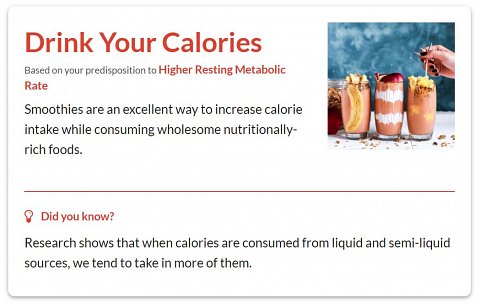
One of my diet tips: Drink Your Calories.
As you can see, I’d been recommended to drink my calories in order to ensure I’m getting enough. Normally, we expect diet tips to be more restrictive. But since these recommendations were tailored to my genotypes, they acknowledged that I may need more calories than the average person due to my high resting metabolic rate. I do actually have a high metabolism, and I was impressed that the test had been able to find this out!
Many of my diet tips had a “Did you know?” section like the one shown above, providing interesting facts about each topic. Others had a “Pro Tip” section that offered further advice. My suggestion to “Include Calorie-Dense Foods at Most Meals” (again based on my high metabolism) contained a Pro Tip that “Foods high in fat are more calorically-dense and could help you meet your calorie needs.”
Each tip, like the one pictured, contained a link to the genetic result that had prompted them. For instance, I had a tip to cook with cold-pressed oil (like coconut or olive oil), which was linked to my result for “Oxidative Stress”, which I was at a higher risk of. Clicking these links took me to the “All Results” section, where I could view the particular genetic results they’d found, and which genetic variants I had which had led to them.
Results Section: Lifestyle
The next section I looked at was “Lifestyle”. The tips here were laid out in the same format as my diet tips. Here, I learned that I have a predisposed injury susceptibility to disc degeneration, which wasn’t exactly thrilling. My tips for this result included getting chiropractic spinal adjustments (if necessary to alleviate lower back pain), and to avoid sitting for too long (shown below).
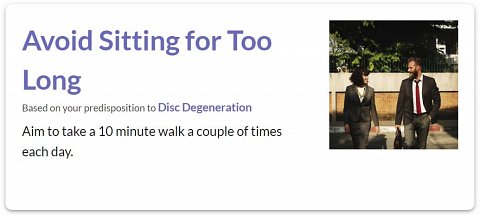
One of my lifestyle tips: Avoid Sitting for Too Long.
To avoid sitting down too long, it was recommended I take a 10 minute walk a couple of times a day. This seemed like it was setting the bar a little low to me, though at the top of each tips page they said I should “Try incorporating one tip a week to help you maintain consistency and turn the tip into a habit.” I took it that this suggestion was along a similar theme: they didn’t want the prospect of incorporating walks into my daily life to seem too daunting, and so they had suggested a goal that anyone could achieve, regardless of their activity level or how busy they are.
I took a look at my “Disc Degeneration” result, and found that they had looked at a variant in my CILP gene, for which my genotype was “AG”. I read that people with my genotype may have an increased risk of degenerative disc disease, which can cause pain in the lower back, neck, hips, or legs. I learned that as running can put additional pressure on the spine, it is important I incorporate techniques to prevent injury. They had also linked the various diet, lifestyle, exercise, and supplement tips associated with this genetic result.
My other lifestyle tips included that I try taking cold showers in order to promote beneficial brown fat, that I “pre-cool” before a workout to improve endurance, that I use vibration therapy or massage to help dispel lactic acid, that I expose myself to a sufficient amount of sunlight in order to get enough D3 (without burning!), and that I meditate or practice mindfulness in order to decrease oxidative stress. I wasn’t sure that these two sorts of stress were linked – but maybe they were!
Results Section: Exercise
The Exercise section contained 11 tips in total. The first was that I incorporate strength training into my exercise regimen (shown below).

One of my exercise tips: Incorporate Strength Training.
As you can see, this recommendation contained a “Pro Tip”, which was more like a Health and Safety notice, really, to make sure I knew what I was doing. Like many of my other tips, I found it was linked to my higher metabolic resting rate. I read that incorporating strength training would help me to gain muscle mass and make sure the weight I gain is healthy weight. They had listed examples of the types of strength training I could do, including pull-ups, bench press, and deadlifts.
Another tip was to “Do More than Just Your Daily Exercise Routine”, which suggested I incorporate physical activity into my daily routine outside of my workouts to make sure I keep active. Again, it was recommended I take a couple of ten-minute walks each day, and they also suggested I park in the back of parking lots (so that I have further to walk), that I try using a physical activity watch (like a Fitbit) to monitor my steps, and that I take the stairs as often as possible. All this would help combat my Obesity Predisposition.
There were pointers about improving running efficiency, linked to my predisposition for Better Endurance Performance. It was suggested I try slower, longer training runs, that I make sure I have properly-fitted, made-to-purpose running shoes, and that I work on my running form. I could improve my form by making sure that my foot strikes the ground parallel to my knee (to avoid injury), to maintain short, quick, comfortable strides, to keep my hands relaxed and below my chest, and to do core exercises to help stabilise my body.
My other tips included warming up, stretching, lower limb resistance training, avoid training outside on poor air quality days (difficult if you live in a city!), avoid overtraining, and to train in the morning, which certain variants in my genes suggested was best for me.
Results Section: Further Testing
The “Further Testing” section turned out to be a list of tests they recommended I have done, based on my genetic predispositions. These were mostly blood plasma tests to check my levels of certain vitamins and minerals, which variants in my genes suggested I might have a lack of. Many of the tests were linked to my predisposition to “Mixed Iron Levels”.
It was also suggested I undergo a DEXA scan to check my bone mineral density due to my predisposition to low calcium levels (shown below).
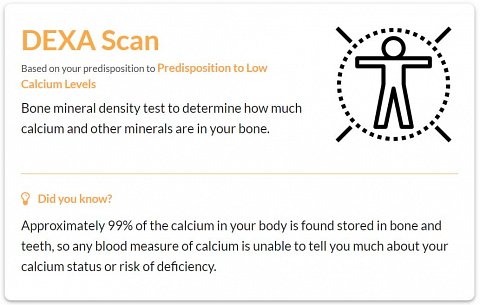
One of my Further Testing tips: a DEXA Scan.
This all seemed a bit extra for me, but for people concerned that they may have certain deficiencies or weaker bone density, this section provided guidance for the sort of tests they could take so that they would know if they should take action.
Results Section: Supplements
The “Supplements” section contained 24 recommendations of different nutrients I should consider taking supplements of. These included several vitamins and minerals such as calcium and magnesium, as well as other nutrients like probiotics and EGEC, which is found in green tea (shown below).
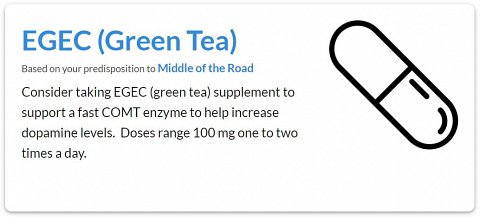
One of my supplement recommendations: EGEC (found in green tea).
Result Section: All Results and Raw Data
The “All Results” section was where all my genetic predispositions were found, which my Diet, Lifestyle, Exercise, and other results had linked to.
Here, I could view my results in another way, by viewing the different genetic variants which contributed to my predispositions, and the associated tips from the Diet, Lifestyle, and other sections.
The “Raw Data” section included more information on the variants in my genes they had looked at for each result.
Summary
Toolbox Genomics’ RunDNA test provided plenty of useful information that was easy to implement. Their recommendations were linked to various genetic predispositions they’d picked out from my genomic data, and included various Exercise, Diet, Lifestyle, and other tips all personalised for me.
While the user interface was a bit peculiar to navigate, once I got the hang of it I discovered the wealth of information behind my recommendations, and could view the variants in my genes that had helped to tailor my results.
Please note we were invited to take this test free of charge.
Visit Toolbox Genomics to learn more about this DNA testing service >
At a Glance
Summary
The ‘Exercise Response’ report by Toolbox Genomics was a well-priced, handy introduction to my genetic fitness. The report was well-presented and clearly laid-out, which made it easy to read and interpret. I was given a decent amount of actionable recommendations, and not too many to be overwhelming. The recommendations I was given were uncomplicated, and felt like they would be easy to incorporate into my lifestyle without going out of my way.
I was pleased to see that they had listed the genes and genetic variants they had looked at, and while I was confident in my results I would have appreciated a list of references at the end to the research papers they had used.
Full Review
Toolbox Genomics is a genetic health services company based in San Francisco, California. The company was co-founded by Erika Gray and Elvina Hewitt, and aims to help people live their healthiest life by utilizing health data to provide personalized dietary and lifestyle recommendations to help reduce the risk of developing chronic conditions.
Product Expectations
I could order Toolbox Genomics’ ‘Exercise Response’ report through the Genejar website, using my genetic data from 23andMe. I saw that my raw data would be analysed to give insights into my biological performance potential, and how my body responds to exercise.
The test would look at just ten of the many thousands of genetic variants contained in my raw data, which they would analyse and interpret to find my genetic predispositions for five exercise-related traits: motivation to exercise, VO2 Max, response to endurance training, weight and fat loss in response to exercise, and endurance performance.
Based on my predispositions, I would receive various health and wellness recommendations on the following areas: lifestyle, nutrition, supplements, exercise, and any further testing that may be suggested.
Ordering Experience
It was simple to order Toolbox’s Exercise Response report through Genejar. As I already had a Genejar account and uploaded my 23andMe data, I was able to add the product to my cart and check out using a billing address and credit/debit card. I was required to read and agree to Toolbox Genomics’ terms and conditions before completing my order.
I soon after received an order confirmation email from Genejar, and received my Exercise Response Health Action Report by email a day or two later. The report was in the form of a PDF, which required a password (my order confirmation number from Genejar).
I wasn’t sure whether this level of security was really necessary, since the report had been sent to my personal email, and didn’t contain anything I wouldn’t want others to see, but it was nice to know Toolbox valued my privacy, and I appreciated this layer of added protection.
The Results
The report opened with an introduction, explaining how Toolbox Genomics followed FDA and scientific guidelines in analysing my DNA, and that they had a gradation system for choosing the best quality research to interpret my genetic data to provide me with health information.
They purposefully provided genetic health information that was actionable, so that I would be able to use Toolbox’s recommendations to improve my wellness. They also added (as I had read in the terms and conditions) that the report was not diagnostic, and was intended for educational purposes only.
There was also a basic introduction into genetics to help me better understand my report.
Results Section: Motivation to Exercise
The results were laid out pretty simply, and the language wasn’t particularly science-heavy, and so they were fairly straightforward to understand.
For Motivation to Exercise, a table told me that I had the CT variants in the BDNF gene (shown below).
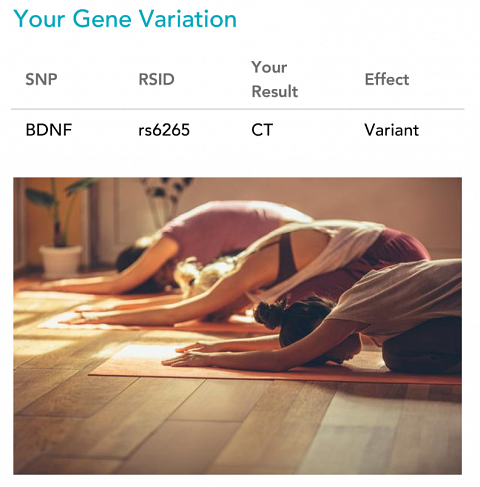
My gene variations for Motivation to Exercise.
A “Gene Definition” told me that BDNF (brain-derived neurotrophic factor) was responsible for producing serotonin and dopamine, which impact the brain’s reward centre. It’s likely that there are many genes responsible for affecting mental state during exercise, and research has shown that variations in the BDNF gene affect intrinsic motivation and likelihood of continuing exercise when given the option to stop.
I discovered that my variant predisposed me to have difficulty staying motivated while exercising, and I read that lack of motivation was a major barrier to regular exercise. I find it easier to stay motivated when I have been exercising regularly. If I am out of practice, then I can be demotivated pretty easily!
For each trait, there were a series of recommendations for making the most out of my genetic predispositions. These could be lifestyle, exercise or nutritional tips. My tips for Motivation to Exercise included getting adequate sleep, and consuming three to four hundred mgs of magnesium per day (shown below).
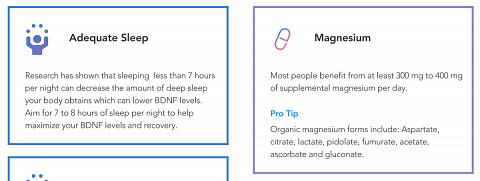
A snippet of my recommendations for improving exercise motivation.
As you can see, some of these recommendations contained “Pro Tips”, such as the different forms of magnesium I could take. I liked that there was a mixture of diet and lifestyle tips, and that these weren’t too complicated, demanding, or overwhelming. I felt like it would be pretty easy to incorporate them into my lifestyle.
Results Section: VO2 Max
The next trait was “VO2 Max”. In the information, I read that this was the maximal rate of oxygen consumption measured during exercise, and refers to how efficient the body is at delivering and utilizing oxygen, which has a direct impact on endurance performance.
I saw that they had looked at two genes: GSTP1 and NFIA. For one, I was described as having the “non-variant”, and for the other as having the “variant” (shown below).
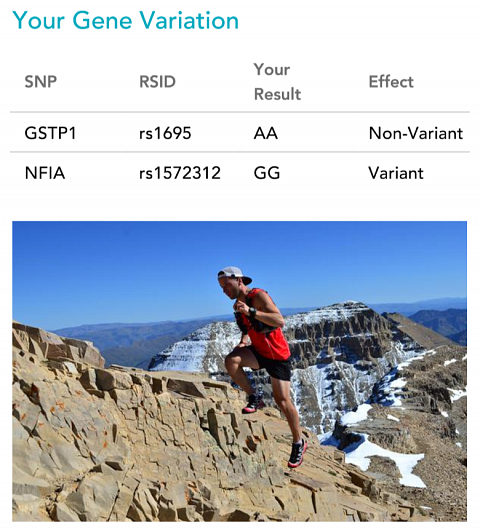
My variations in two genes relating to VO2max.
I wasn’t sure what this meant for my results, but read that people with similar genetic markers to mine may be predisposed to a higher VO2max and an increased VO2 response to training.
In the gene definitions, I read that variations in the GSTP1 gene (for which I was “non-variant”, meaning, I assume, that I had the more common gene version) were associated with greater improvements in VO2max in response to training. For the NFIA gene, the variants I had were associated with increased aerobic capacity and higher VO2max in endurance athletes.
Overall, it seemed, I was predisposed to a higher VO2max if I undertook endurance training, though I didn’t have the most favourable mutations in one of the genes analysed.
Among the tips for improving VO2max, they suggested I get my VO2max tested at a gym, and gave the average values for men and women.
Results Section: Response to Endurance Training
For Response to Endurance Training, I found that they had looked for a variation in my AMPD1 gene, associated with exercise capacity and cardiorespiratory responses to endurance training. I found that the version I had meant that I was predisposed to a lower or delayed cardiorespiratory response.
This meant that although another gene had predisposed me to a higher VO2max through endurance training, I was also disposed to a lower or delayed cardiorespiratory response. There were no recommendations for this result, but I supposed the tips for improving VO2max would also be helpful here.
Results Section: Weight and Fat Loss in Response to Exercise
For Weight and Fat Loss in Response to Exercise, I read that people with my genetic markers may find it harder to lose weight through certain types of exercise. I had the “non-variant” version of the FTO gene. I read that variations in this gene makes cells fat-storing instead of fat-burning, increasing overall body fat and BMI. I discovered that individuals with these variations may have more success burning fat through more frequent and intense workouts.
Results Section: Better Endurance Performance
For Better Endurance Performance, I saw that Toolbox had analysed five genetic variants in four genes, and that altogether my genetic markers predisposed me to better performance in endurance exercise.
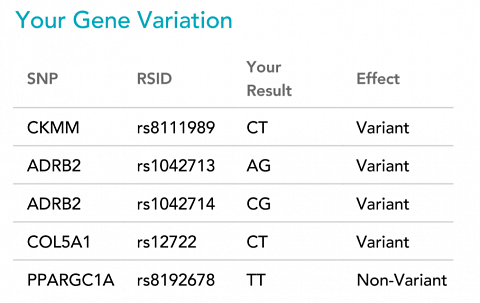
My variations in the genes associated with endurance performance.
I looked through the descriptions of the four genes analysed. CKMM was responsible for creating the enzyme creatine kinase, which supplies energy for muscle performance, and the others also related to processes in the body to enhance endurance.
There were quite a few recommendations for improving endurance performance, spanning diet, supplements, lifestyle and exercise. These included fluid recommendations to work out how much I should drink per day and while running, strategies to improve running efficiency, and lowering core body temperature to improve endurance performance (shown below).
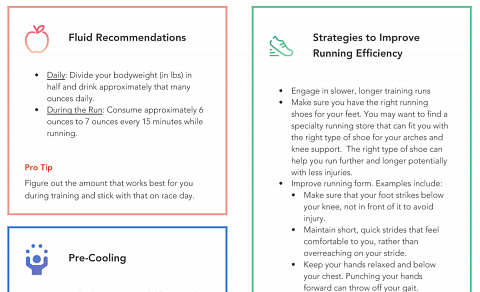
A snippet from my tips for Better Endurance Performance.
I was pleased to see how many tips there were for this section, since improving endurance is a major part of any fitness regimen, and great for cardiovascular health.
Summary
The ‘Exercise Response’ report by Toolbox Genomics was a well-priced, handy introduction to my genetic fitness. The report was well-presented and clearly laid-out, which made it easy to read and interpret. I was given a decent amount of actionable recommendations, and not too many to be overwhelming. The recommendations I was given were uncomplicated, and felt like they would be easy to incorporate into my lifestyle without going out of my way.
I was pleased to see that they had listed the genes and genetic variants they had looked at, and while I was confident in my results I would have appreciated a list of references at the end to the research papers they had used.
Visit Toolbox Genomics to learn more about this DNA testing service >
At a Glance
Summary
I really enjoyed the Health Action Report from Toolbox Genomics. It not only provided useful tips but several helpful features that made them easy to implement, such as the grocery list and recipe suggestions. I would have liked to have been able to access the further information about my results a little more directly, and it was a shame that none of the examples of published work from the website were present in the report.
That said, I appreciated the focus on the advice and practical implications of the DNA report. Rather than just providing results that I was left to interpret and act on alone, I felt that the company had considered the customer’s experience and supported me at every point in the process. Overall, this report was a good value service that allowed me to get extra information, as well as easily actionable advice, about my health and lifestyle using my 23andMe results, and I wouldn’t hesitate to recommend it to others.
Full Review
The Health Action Report is the first testing tool offered by Toolbox Genomics, a company which entered the health DNA testing market only last year. Headed up by co-founders Erika Gray and Elvina Hewitt, the company currently offers 23andMe customers the opportunity to have their genetic data reanalysed to provide information about their health.
However, they have plans to expand their products as the company grows, to offer their own kits and analysis to customers that haven’t already got their genetic data, and to offer a professional version of the test for use by healthcare professionals. We were excited to try out the Health Action Report and were particularly interested to see how well the current test offered by Toolbox Genomics would compare to some of the more well established tests.
Product Expectations
The Toolbox Genomics website was really nicely laid out, which made it easy to find out about the report. I read that it was designed using the most up-to-date science, to provide me with lifestyle and food recommendations based on my DNA. There was an emphasis on the fact that these would be practical and actionable, which I was happy about, as although I was interested in finding out about the scientific side of the results, my ultimate reason for using the service was to improve my lifestyle. I think this focus showed that the company had really thought about what their customers wanted from the report.
There were also a few sample pages of the report, which were frustratingly a bit too small to read, but provided a good idea of what to expect in my results. Below this there was a ‘how it works’ section and a ‘What’s included’. I found out that as well as the report, the price of the service included a Toolbox Genomics subscription that would last for the rest of the year. This provided, amongst other features, recipes, health and genomic related articles and supplement tips, so it was a real bonus that it was included in the price of the service.
As well as information about what came with the report, there was a section that highlighted the efforts that Toolbox Genomics takes to protect customers’ privacy. I was pleased to read that they wouldn’t permanently store my genetic data and wouldn’t share it for commercial purposes or to insurers and employers. I was also impressed to see that they highlighted the Genetic Information Discrimination Act (GINA), which isn’t something people are necessarily aware of. Unfortunately, I found out that GINA is a piece of US legislation, which doesn’t really have a UK counterpart, but this made me all the more glad that the company had made their policies protective and clear.
There was also a link to the full privacy policy, which confirmed what was stated. It was also explained that Toolbox Genomics wouldn’t knowingly test samples taken from those under the age of 18. The terms and conditions were similar, though did include a clause that meant if the company uses my data for research that leads to any discoveries or the development of any products, I won’t not be able to claim any compensation for my contribution.
Ordering Experience
Before ordering the Health Action Report, I had to indicate that I understood and accepted a list of conditions. This seemed odd, as these terms were in addition to those set out in the terms and conditions and privacy policy that I also had to agree to. However, they all seemed quite sensible so I clicked to indicate that I understood and accepted them.
I paid via credit card and was then able to connect to my 23andMe account to transfer a copy of my raw genetic data. Whilst this was probably the easiest method, I would have liked to have had the option to upload the file from my computer, as, for me, this was easier to access than my 23andMe login details, which I hadn’t used for a while.
The Results
My report was instantly available once I’d transferred my genetic data, online and in a printable form and accessible at any time via the account I had made when ordering the report. The first page I was shown was ‘Here's what's new for you’ which seemed to be blog posts and guides from the website. The rest of the report was broken up into the following sections: ‘Summary’, ‘Diet’, ‘Exercise’, ‘Further Testing’, ‘Supplements’ and ‘All Results’.
Results Section: Summary
I was expecting the ‘Summary’ section to provide a bit of a background about the test and maybe an introduction to the results, but was pleased to find it was even more useful. A part of this section is shown below.
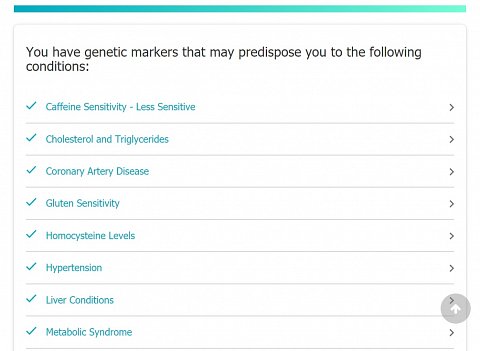
A part of the Summary section of my report.
The section was used to highlight my most significant results, with the option to view non-detected conditions, and it was suggested that I chose just one condition to focus on at first, to maximise my success at improving my health and lifestyle. It acknowledged that going through a report might be a bit overwhelming, which I definitely agreed with. I really appreciated that Toolbox Genomics had not only noted this, but had responded to it by providing this section. It seemed like they had really thought from a customer’s point of view when designing the report, finding the best format in which to provide an abundance of information in a manageable way.
The list of highlighted results helped me to choose the one condition to act on first, but also to get an idea of which results to focus on before going on to read any of them in more detail. Something that was even more useful was the list beneath of the top three tips provided for each section (Diet, Exercise, Further Testing, Supplements). These lists added to how easy the report was to interpret and implement.
In addition to providing such a comprehensive overview of the report, this section served as a helpful contents page. Each of the highlighted conditions was hyperlinked to the result that went into more detail about it, making it really easy to check the ones I was most interested in, rather than having to go through all of the results to find it.
Results Section: Diet
Unusually, rather than results, the report was sorted into different categories of tips. I decided to look at the diet ones first, as this was the category that contained the most, 30 in total. You can see an example of one of my diet tips below.
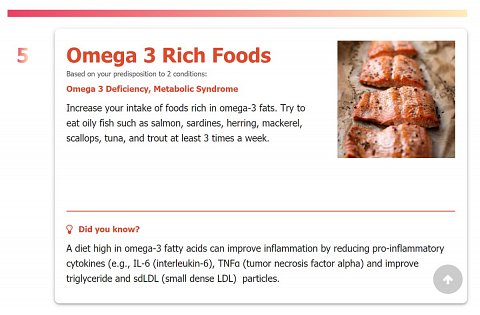
One of my diet tips.
These tips were all formatted in the same way and provided information about specific foods, groups of foods, as well as foods high in certain vitamins and minerals. Each varied in the content but all of the tips were very specific and easy to implement, including suggested foods, measurements, and even sometimes how many times per week I should eat them. Each result also included information about the advice, and the benefits of the foods/vitamins suggested. Some results included a fun ‘Did You Know?’ fact or ‘Pro Tip’, which provided interesting information about the advice.
Each of the tips also included links to any results that were associated with them. Although this seemed an unusual way around to show the information, I think this again exemplified that rather than just providing abstract results that are difficult to understand or utilise, Toolbox were aiming to provide practical, easily implementable advice, based on my DNA.
These results were found on the ‘All Results’ page, which was a long list of results from all of the categories, so it was useful to have a link that took me straight to the one I was looking for.
This section of the report also gave a list of suitable groceries under the subheading at the top ‘View all Groceries’, which was my favourite feature of the report. The list could be filtered by up to three conditions I wanted to focus on. I had hoped that some of the diet tips to be hyperlinked or listed alongside the groceries, but unfortunately this wasn’t the case. You can see an example below, based on the following three conditions: Cholesterol and Triglycerides, Coronary Artery Disease and Hypertension.
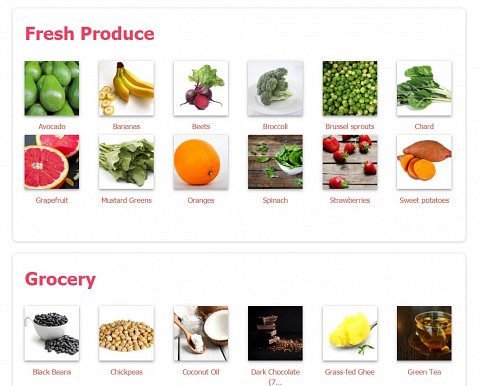
A section of one of the grocery lists, customised according to my chosen conditions.
As well as the ‘Fresh Produce’ and ‘Grocery’ categories shown in the screenshot, there were sections that listed Dairy, Nuts and Seeds, Meats and Seafoods, Spices, and Supplements. The addition of this feature made it even easier to implement the advice given in the main report, especially as it included normal grocery items that I could easily pick up at any local supermarket.
Another feature I was really impressed by in the Diet section was the recipe suggestion given on various ingredients. When I clicked on ‘More Recipes’ next to the first suggested recipe, I was taken to a page that listed an array of tasty looking recipes that didn't seem too difficult to follow, with helpful ‘Chef's Tips’. I was suggested seven recipes, each one labelled with the conditions they were suggested for, and similarly to the grocery list, the filter feature allowed me to choose them based on up to three conditions I wanted to target.
Results Section: Exercise
I looked at the Exercise section next. There were only seven tips in this section, and unfortunately not all of these were as detailed than the diet ones, but still interesting and helpful. I was recommended to undertake yoga, dancing, meditation, hill walks, indoor rather than outdoor exercise during periods of extra high pollution and a combination of endurance and strength activities.
One of the tips was slightly confusingly entitled ‘General Exercise’ and just advised me to exercise for at least two hours per week. I thought that as this was a bit vague compared to the other tips, it might have been better as part of the introduction to the section rather than a separate tip.
In contrast, I was impressed by how detailed the ‘Combined Training’ advice was, telling me to spend two days on endurance and three days on strength-type exercises. The accompanying ‘Did You Know?’ box also included suggested activities, which helped to clarify exactly what was meant by strength and endurance. This tip was based on my result, ‘Muscle Composition – Mixed Athletes’ (shown below).
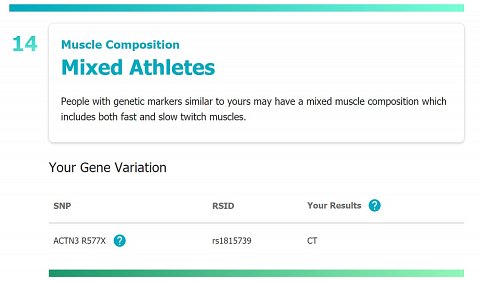
My Muscle Composition – Mixed Athletes result.
At first, I was slightly disappointed with the description of my result, as although it explained that I had both ‘fast and slow twitch muscles’ I wasn’t sure what this meant, or how they had worked this out. However, I noticed later that clicking on the little question mark symbol next to the gene listed under ‘SNP’ in the table provided me with more information about the gene tested and its link to the result. I was also able to read a bit about what my result (CT) meant in genetic terms, by clicking on the question mark next to ‘Your Results’. In addition, the advice from the Exercise page was also included, beneath the result, which put it into better context. All together, this provided plenty of information, I just wished it had been easier to find!
Results Section: Further Testing
The next section was a bit different. It was dedicated to suggested further testing, which I had initially assumed meant DNA testing. Instead, it was testing that seemed to be designed to see whether the predispositions identified using my DNA were actually manifesting in the conditions predicted. These were less tips than guidelines about the typical levels I should have, so if I did get the tests suggested, I could compare to see if they were in the normal range. Whilst this was interesting, I’m not sure how much I will use this feature of the service.
Results Section: Supplements
The supplement tips were similar to the diet tips in being quite specific. There were 26 of these in total and they provided suggested doses and the number of times per week I should take them. There was also a feature, at the top of the page, that allowed me to select the tips by condition (shown below).
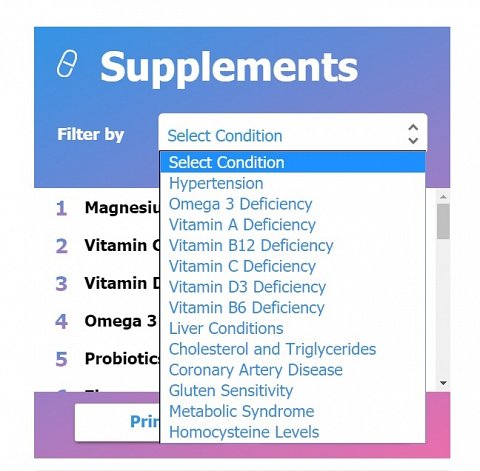
My supplement tips sorted by condition.
Although this was a feature of each of the sections, I found it particularly useful for this one. It meant that I could quickly and easily select supplements for the conditions I was most worried about (eg. Coronary Artery Disease), before maybe incorporating those that would help guard against the less serious ones at a later point. This linked in well with the idea, mentioned at the beginning of the report, of focusing on one condition at a time to slowly and sustainably improve my lifestyle.
Results Section: All Results
The final section gave a summary of the most relevant tips from each section for all 16 gene variations detected by the test. Seeing this condensed layout of the recommendations was a great way to recap the masses of information in the previous sections, and as they suggested, to start with small, manageable changes that make the process much less daunting.Summary
I really enjoyed the Health Action Report from Toolbox Genomics. It not only provided useful tips but several helpful features that made them easy to implement, such as the grocery list and recipe suggestions. I would have liked to have been able to access the further information about my results a little more directly, and it was a shame that none of the examples of published work from the website were present in the report.
That said, I appreciated the focus on the advice and practical implications of the DNA report. Rather than just providing results that I was left to interpret and act on alone, I felt that the company had considered the customer’s experience and supported me at every point in the process. Overall, this report was a good value service that allowed me to get extra information, as well as easily actionable advice, about my health and lifestyle using my 23andMe results, and I wouldn’t hesitate to recommend it to others.
Please note that we were invited to take this test free of charge.
Visit Toolbox Genomics to learn more about this DNA testing service >


